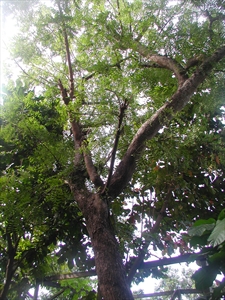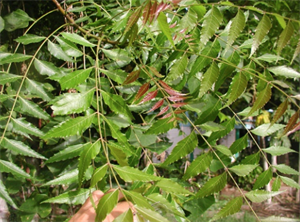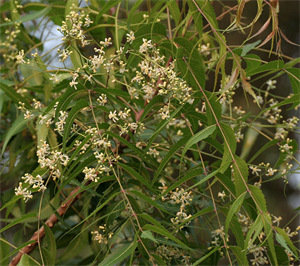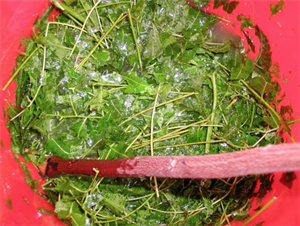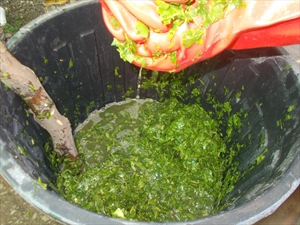Neem
Pacific Pests, Pathogens, Weeds & Pesticides - Online edition
Pacific Pests, Pathogens, Weeds & Pesticides
Neem (preparation & use) (402)
Azadirachta indica
South and Southeast Asia, Africa, South and Central America, the Caribbean, Oceania. It is recorded from Australia, Fiji, Solomon Islands, and other Pacific island countries.
Neem is a tree of the mahogany family (Photo 1). It is fast-growing, up to 20 m, evergreen, but may lose leaves in drought. Leaves up to 40 cm long with a flexible central midrib, bearing 20-30 paired leaflets, each one 3-8 cm long and attached to the midrib by a short stalk (Photo 2). Flowers are in clusters (Photo 3). The fruits are green, yellow when ripe, almost oval, olive-shaped, up to 3 cm long and 1.5 cm wide (Photo 4).
Neem is used in many ways: it improves soil fertility, so it is used in reclamation projects; it is made into plywood because it is resistant to termites, borers and decay by fungi; and it is used to treat scabies and lice affecting humans, and fleas on cats and dogs. It is also used as a vegetable, and in traditional medicines to cure many ailments.
Extracts from leaves and seeds are used as a pesticide (Photos 5-7). The most active chemical in them - azadirachtin - repels and kills insects and nematodes.
As a pesticide against some insects and nematodes:
- Neem extract can protect your crops against moths, aphids, leaf and plant hoppers, leaf miners, grasshoppers, scale insects, whiteflies and nematodes.
- Spray neem all over the leaves, but especially the undersides where insects like to hide. If you have any left over, drench the soil around the roots as well.
- Do not spray in full sun as neem may cause leaf burn. Also, apply in the evening to avoid the azadiractin being destroyed by sunlight.
- Spray at least once every 2 weeks.
- Wait at least 3 days after spraying before harvesting the crop.
Method 1 - FRESH LEAVES
- Collect 1 kg of green leaves in a strong bowl or bucket (Photo 5)
- Add 5 litres of water
- Soak the leaves overnight (12 hours) OR pound the leaves with a heavy stick- like a baseball bat and soak overnight (Photo 6).
- If not pounded, remove the leaves to another bowl or bucket, and keep the water; pound the leaves, and squeeze out the liquid. Combine the two liquids.
- If already pounded, collect leaves and squeeze out the liquid (Photo 7)
- For both lots, strain the liquid through a kitchen sieve or muslin cloth to remove leaf pieces.
- Add about 20 g soap into a small amount of water until dissolved.
Note, you can use the liquid from the leaves for up to 1week after preparation; but it is best to store in a cool, dark place.
Method 2 - DRIED LEAVES
- Collect green neem leaves and dry them away from direct sunlight
- Store the leaves in a container which allows plenty of air around the leaves
- Put 250 g of dried neem leaves in a strong bowl or bucket
- Add 5 litres of water
- Let the leaves soak overnight
- Pound the leaves using a heavy stick - like a baseball bat. Soak the leaves again overnight
- Squeeze out the liquid, strain using a kitchen sieve or muslin cloth into a sprayer
- Add about 20 g soap into a small amount of water until dissolved and pour into the sprayer with the liquid from the leaves.
Method 3 - SEEDS
See the cartoon video from the University of Illinois (https://www.youtube.com/watch?v=6U4FMgFdVAM)
- Select ripe fruits which are yellow
- Let the fruits dry in the sun for 3-4 days until they turn brown
- Pound the fruits to remove the seeds without breaking them. This is best done in a wooden bowl with a heavy stick - like a baseball bat
- Winnow, i.e, allow wind to blow through the fruits to separate the shells from the seeds. Throw away any light coloured seeds; keep the darker ones
- Pounds the seeds in the wooden bowl to crush them into a fine powder
- Use 250 g (5 handfuls) of powder to 5 litres water, and mix well
- Soak the mixture for 24 hours
- Strain the liquid using the kitchen sieve or muslin cloth into a sprayer
- Add about 20 g soap into a small amount of water until dissolved and pour into the sprayer with the liquid from the seeds.
If using a knapsack sprayer, keep the nozzle about 50 cm about the crop and spray over 250 m2 Keep the sieve and muslin used only for making neem spray. Do not use for food.
Note, you can use the leaves and seeds after pounding. Spread them around the crop to repel insects and also as a manure.
Neem is generally considered to be of low toxicity to humans, but that does not mean people should drink large amounts, allow it to contact skin or eyes, or inhale the dust when preparing dried leaves or seed. It should be treated like all pesticides: when working with neem take care. Wear protective clothing when you are preparing and applying it. The kinds of protective clothing to use are outlined in Preparing natural pesticides (Fact Sheet no. 056) and the Pesticide label - how to read it? (Fact Sheet no. 288).
In some parts of the world neem is invasive. In the Northern Territory of Australia, it invades waterways and has been declared a weed. However, because of its drought resistance (it can grow in regions with less than 400 mm rain) it is used as a shade tree in urban and rural areas.
AUTHOR Grahame Jackson & Kazuko Ota
Information from Azadirachta indicata (Neem) Bio-NET-EAFRINET. (https://keys.lucidcentral.org/keys/v3/eafrinet/weeds/key/weeds/Media/Html/Azadirachta_indica_(Neem).htm); and Azadirachta indica Wikipedia. (https://en.wikipedia.org/wiki/Azadirachta_indica); and from Campos EVR (2016) Neem oil and crop protection: from now to the future. Froniersin Plant Science. (https://www.frontiersin.org/articles/10.3389/fpls.2016.01494/full). Photo 3 JM Garg Azadirachta indica in Hyderabad, India.
Produced with support from the Australian Centre for International Agricultural Research under project HORT/2016/185: Responding to emerging pest and disease threats to horticulture in the Pacific islands, implemented by the University of Queensland and the Secretariat of the Pacific Community.
